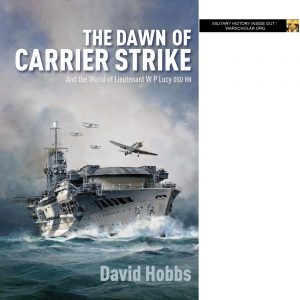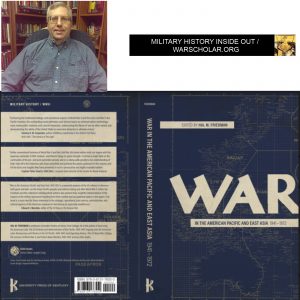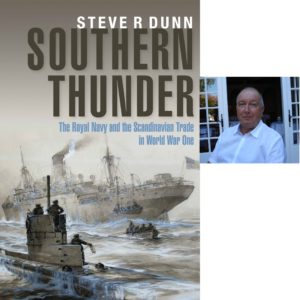https://www.pen-and-sword.co.uk/The-Dawn-of-Carrier-Strike-Hardback/p/15667
When it comes to modern naval warfare, aircraft carriers have a huge hold on popular imagination. Giant behemoths sailing across vast expanses and sending off squadrons of deadly aircraft taking the fight to the enemy. But how often do people think about what it took to develop such formidable fighting machines?
The United States Navy was very successful in utilizing aircraft carriers in World War II and so might it be said were the Japanese except for the fact that they had to fight the Americans. Unfortunately, the work of the British Royal Navy in developing the aircraft carrier before WWII is not often considered. Their efforts are not as widely discussed.
David Hobbs is making the effort to remind us all of British aircraft carrier development and operations with his new book on the subject. I spoke with him about his book The Dawn of Carrier Strike and their struggle to ensure victory in the next great war that was expected to follow WWI.
How did you become interested in studying and writing on the subject of your book?
I have always been fascinated by the Royal Navy’s Fleet Air Arm and have written extensively about its history. This book fills the gap between my earlier books on The British Pacific Fleet (Seaforth, 2011 and further editions) and The Royal Navy’s Air Service (Seaforth, 2017). Other titles in the series include The British Carrier Strike Fleet after 1945 (Seaforth, 2015), British Aircraft Carriers (Seaforth, 2013) and A Century of Carrier Aviation (Seaforth, 2009). I am working on the next book in the series which will cover the attack on the Italian Fleet at Taranto in 1940 by RN Swordfish torpedo-bombers and naval air warfare in the Mediterranean from 1940 to 1944.
What are the major themes of this book?
I describe the continuing development of naval aviation between 1918 and 1940, culminating in the first carrier strike operations ever carried out by any navy and use, as an example, the naval career of Lieutenant William Paulet (Bill) Lucy DSO RN. He was the first British fighter ‘ace’ of the Second World War and led the first air attack to sink a major enemy warship, the German cruiser Konigsberg.
After WWI, how much emphasis did the British government put on supporting the advancement of carrier operations and technology? Was there any post WWI war weariness that affected the Royal Navy’s development of new tactics and techniques?
WW1 war weariness had no discernible effect on RN tactics and techniques as they evolved from 1919 onwards. The Admiralty had invested heavily in aircraft prior to the Armistice as a means of taking the fight to the enemy in his harbours, locating enemy ships at sea and countering the U-boat threat. After the war the Admiralty wanted to go on developing aircraft as a means of maintaining its edge over any navy that might pose a potential threat to the British Empire. The problem was the existence of the newly independent air force which was seen by the Government as the focal point on all air matters but which had no interest in naval warfare and opposed every Admiralty attempt to increase the number of aircraft that could be embarked in His Majesty’s ships as well as the uses to which they could be put. The problem was not resolved until 1937 when the Minister for Defence Co-ordination returned full control of aircraft embarked in ships and their support facilities ashore to the Admiralty.
How much tension and how much cooperation was there between the RAF and the Royal Navy Fleet Air Arm in developing flight technology and operations? I imagine resources were limited in the period between 1918 and 1940 and the two services might have been very competitive in the political arena.
The period of dual control which afflicted the Fleet Air Arm between 1918 and 1937 severely limited the development of aviation for naval purposes. The US and Japanese navies suffered no similar restriction and although they were far behind Britain in capability in 1919, both drew well ahead by 1939. The RAF concentration on strategic bombing was a disastrous policy that led to near defeat in 1940 when British forces were opposed in Norway, Belgium and France by German air units trained to give tactical support to their army and RAF bombers made no effective contribution to the war. It was not so much that the two services were competing for resources, more that the Government accepted every theory put forward by the RAF without realising that it needed to be tested. More could have been achieved with less had it not been for theoretical RAF dogma. Note the absurdity of RN pilots having to have RAF ranks, which were often not the same as their RN rank, whereas observers, who were not recognised as aircrew by the RAF did not.
Who were the major leaders in the Royal Navy as far as pushing the advancement of carrier operations forward?
All of them to a certain extent. If I had to single out any by name who were exceptional they would be:
Admiral Chatfield, the First Sea Lord who won back full control of the Fleet Air Arm for the RN in 1937.
Admiral J D Cunningham, Assistant Chief of the Naval Staff who helped Chatfield in his fight to regain full control of the Fleet Air Arm. Later became First Sea Lord himself.
Admiral Bell Davies VC, a veteran of the RNAS and the first pilot in the world to land on and take off from an aircraft carrier, he served in the Admiralty between the wars and was Rear Admiral Naval Air Stations when the Admiralty resumed full control from 1937.
Admiral Henderson, Rear Admiral Aircraft Carriers and the Third Sea Lord/Controller, who re-organised the Fleet Air Arm into the system of squadrons still in use today and was later responsible for the armoured carriers of the Illustrious class – the world’s biggest aircraft carrier construction programme in 1939.
Admiral Lyster, Rear Admiral Aircraft Carriers Mediterranean, the visionary behind the strike on the Italian Fleet at its harbour in Taranto.
Captain Boyd, another visionary who believed in naval aviation and commanded HMS Illustrious during the Taranto attack.
Admiral de Robeck, C-in-C Mediterranean in the early 1920s who first pointed out the failure of the RAF to provide the aircraft the navy needed to do its job.
The whole RN believed implicitly in the use of aircraft in sea warfare and agreed that it was let down by the RAF and successive Governments that failed either to recognise the problem or do anything to remedy it.
Are you able to touch on the major engineering changes that occurred in both the aircraft and with the carriers (landing area configurations, landing gear, locations of the island, elevators, etc.) during this period and how effective these changes were?
Changes in aircraft technology included brakes which allowed aircraft to run up to full power before starting a take-off roll, thus shortening it, and to taxi out of a densely-packed range aft, effectively increasing the number of aircraft that could be launched at any one time. Night/blind flying instrumentation that allowed aircraft to operate at night or in bad weather. Aircraft engines in the 1,000 horse power class not only enabled higher speeds but greatly increased the load-carrying capacity of naval aircraft. Aircraft of all-metal, monoplane construction proved to be faster and more robust than their biplane predecessors.
Aircraft armament improved dramatically in this period although here, too, the pedestrian policies followed by the RAF were of little value. Airborne torpedoes with explosive warheads designed specifically for them proved to be the best ship-killing weapons of the war. Armour-piercing bombs dropped by dive bombers (which the RAF said would never work) also proved effective. 20mm cannon replaced rifle-calibre machine guns in the air-to-air role and proved far more effective. Early depth charges specified by the RAF proved to be of little value and were replaced by Admiralty-designed weapons that proved far more effective in the Battle of the Atlantic.
Aircraft carrier developments included the safety barrier that protected aircraft that had just landed from those landing after them and allowed much quicker landing times by larger numbers of aircraft. The deck landing control officer or ‘batsman’ produced more accurate landings and helped to speed up landings by large numbers of aircraft. The starboard-side island proved a great success as did special flight deck lighting which allowed aircraft to take-off and land safely in the dark. Development of catapults for use in battleships and cruisers as well as aircraft carriers was carried forward successfully between the wars and the Admiralty invested heavily in the former to use aircraft for reconnaissance as well as correcting the gunfire of battleships and cruisers in surface actions. The 6 armoured carriers of the Illustrious class were a great technological achievement. Armoured flight decks saved at least two ships from probable destruction when hit by enemy dive-bombers in the Mediterranean and kamikazes in the Pacific and minimized damage to others.
Who were the major enemies that the Royal Navy was most worried about and how did that affect how they approached carrier operations? How did these worries change during the inter-war period?
Until Nazi Germany started to re-arm after 1933, Japan was seen as the most likely enemy since it coveted the oil and mineral wealth controlled by Great Britain and the Netherlands in the Far East. From 1935, Germany became the most likely enemy although Italy was seen as a major threat after the Abyssinian Crisis in 1935. The possibility of war with all three had to be accepted as a real possibility when British re-armament began in 1936. RAF bombers proved to be of no help to the RN in operations against Italy or Japan and of only marginal maritime use against Germany.
What resource materials did you use for your research?
I have an extensive library and archive of books, documents and images built up over many decades of research. The Lucy family made a number of invaluable documents and photographs available for which I was most grateful. The list of primary and secondary source material fills 5 pages in the book’s Bibliography, much of it researched from the collections in the National Archive at Kew, the Ministry of Defence Archive formerly at Hayes, the Naval Historical Branch at Portsmouth and the Fleet Air Arm Museum.
What part of the research process was most enjoyable for you?
I find all reading and research into the subject enjoyable.
Was there anything that you discovered that moved you?
Having access to the Lucy family archive meant a great deal. The letters written to Bill Lucy’s father after he was killed in action over Norway in May 1940 moved me. They ranged from His Majesty King George VI, through Admirals and Captains to the men of 803 Naval Air Squadron that he led so successfully in action from RNAS Hatston and the aircraft carriers Glorious and Ark Royal.
What do you hope the book will do for readers?
I hope it will inform the public how much was achieved by the Royal Navy’s air arm. Many people think that the leader in carrier aviation was the US Navy. However, much of the development was carried out by the Royal Navy and later adopted by the USN. There is also a mistaken view that the RAF carried out every air combat but I show that it was the Royal Navy’s Fleet Air Arm that had to fight in the sky over Norway in the Spring of 1940. In the final chapters I explain that the German Luftwaffe deployed about 800 combat aircraft to this campaign. They were opposed by a handful of gallant RN carrier-borne aircrew with about 30 Blackburn Skua fighters which were actually slower in level flight than every enemy aircraft but for several weeks it was the Skuas that had the best of every airborne fight. Not only did they deter enemy bombers from attacking ships and the Allied troops ashore, the same aircraft and aircrew attacked enemy airfields, ships and forces on the ground with bombs. Their story deserves to be widely understood and remembered. More than half of them were killed in action, including Bill Lucy and his observer Lieutenant Michael Hanson DSC RN.
What is your next writing project?
My next writing project follows logically on from ‘The Dawn of Carrier Strike’ and describes the attack by Swordfish aircraft from HMS Illustrious on the Italian Fleet at Taranto in November 1940 and naval air warfare in the Mediterranean between 1940 and 1945. The manuscript is to be with Seaforth publishing in late 2020 for publication early in 2021.
Author Biography
Name Commander David Hobbs MBE RN (Retired)
Position Independent naval historian
Biography Mr. Hobbs served in the Royal Navy from 1964 to 1997 and retired with the rank of Commander. During that time he qualified as both a fixed and rotary-wing pilot and his log book contains 2,300 flying hours and over 800 deck landings. During one appointment in the Ministry of Defence he developed carrier operating techniques for the Invincible class light carriers including the operation of Sea Harriers at night and in bad weather which were facilitated by the Deck Approach Projector Sight, a concept he drove forward. For three years he was the RN representative in an Information Exchange Programme with the US Navy, through which he was closely involved with AV-8A Harrier trials at sea.
After retiring from the Royal Navy Mr. Hobbs was the Curator of the Fleet Air Arm Museum at Yeovilton for eight years and is now a full-time independent historian. He has written books and articles for journals over a number of years, winning the Aerospace Journalist of the Year, Best Defence Submission in Paris in 2005 and the Navy League of Australia Essay prize in 2008. He lectures on naval subjects world-wide, including on cruise ships, and has appeared on radio and television in several countries. his first book was published in 1982 while he was still serving in the RN and since then he has written many more.
Work being discussed THE DAWN OF CARRIER STRIKE
and the world of Lieutenant W P Lucy DSO RN
Seaforth Publishing – Barnsley – 2019
https://www.pen-and-sword.co.uk/The-Dawn-of-Carrier-Strike-Hardback/p/15667



